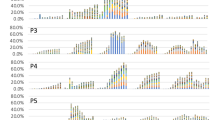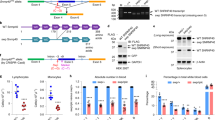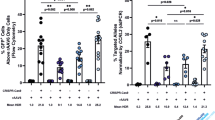Abstract
Artemis deficiency is known to result in classical T−B− severe combined immunodeficiency (SCID) in case of Artemis null mutations, or Omenn's syndrome in case of hypomorphic mutations in the Artemis gene. We describe two unrelated patients with a relatively mild clinical T−B− SCID phenotype, caused by different homozygous Artemis splice-site mutations. The splice-site mutations concern either dysfunction of a 5′ splice-site or an intronic point mutation creating a novel 3′ splice-site, resulting in mutated Artemis protein with residual activity or low levels of wild type (WT) Artemis transcripts. During the first 10 years of life, the patients suffered from recurrent infections necessitating antibiotic prophylaxis and intravenous immunoglobulins. Both mutations resulted in increased ionizing radiation sensitivity and insufficient variable, diversity and joining (V(D)J) recombination, causing B-lymphopenia and exhaustion of the naive T-cell compartment. The patient with the novel 3′ splice-site had progressive granulomatous skin lesions, which disappeared after stem cell transplantation (SCT). We showed that an alternative approach to SCT can, in principle, be used in this case; an antisense oligonucleotide (AON) covering the intronic mutation restored WT Artemis transcript levels and non-homologous end-joining pathway activity in the patient fibroblasts.
This is a preview of subscription content, access via your institution
Access options
Subscribe to this journal
Receive 6 digital issues and online access to articles
$119.00 per year
only $19.83 per issue
Buy this article
- Purchase on Springer Link
- Instant access to full article PDF
Prices may be subject to local taxes which are calculated during checkout





Similar content being viewed by others
References
Cowan MJ, Neven B, Cavazanna-Calvo M, Fischer A, Puck J . Hematopoietic stem cell transplantation for severe combined immunodeficiency diseases. Biol Blood Marrow Transplant 2008; 14: 73–75.
Pike-Overzet K, van der Burg M, Wagemaker G, van Dongen JJ, Staal FJ . New insights and unresolved issues regarding insertional mutagenesis in X-linked SCID gene therapy. Mol Ther 2007; 15: 1910–1916.
Cavazzana-Calvo M, Fischer A . Gene therapy for severe combined immunodeficiency: are we there yet? J Clin Invest 2007; 117: 1456–1465.
Buckley RH, Schiff RI, Schiff SE, Markert ML, Williams LW, Harville TO et al. Human severe combined immunodeficiency: genetic, phenotypic, and functional diversity in one hundred eight infants. J Pediatr 1997; 130: 378–387.
Geha RS, Notarangelo LD, Casanova JL, Chapel H, Conley ME, Fischer A et al. Primary immunodeficiency diseases: an update from the international union of immunological societies primary immunodeficiency diseases classification committee. J Allergy Clin Immunol 2007; 120: 776–794.
McBlane JF, van Gent DC, Ramsden DA, Romeo C, Cuomo CA, Gellert M et al. Cleavage at a V(D)J recombination signal requires only RAG1 and RAG2 proteins and occurs in two steps. Cell 1995; 83: 387–395.
van Gent DC, McBlane JF, Ramsden DA, Sadofsky MJ, Hesse JE, Gellert M . Initiation of V(D)J recombination in a cell-free system. Cell 1995; 81: 925–934.
Weterings E, van Gent DC . The mechanism of non-homologous end-joining: a synopsis of synapsis. DNA Repair (Amst) 2004; 3: 1425–1435.
Douglas P, Sapkota GP, Morrice N, Yu Y, Goodarzi AA, Merkle D et al. Identification of in vitro and in vivo phosphorylation sites in the catalytic subunit of the DNA-dependent protein kinase. Biochem J 2002; 368: 243–251.
Ma Y, Pannicke U, Schwarz K, Lieber MR . Hairpin opening and overhang processing by an Artemis/DNA-dependent protein kinase complex in nonhomologous end joining and V(D)J recombination. Cell 2002; 108: 781–794.
Benedict CL, Gilfillan S, Thai TH, Kearney JF . Terminal deoxynucleotidyl transferase and repertoire development. Immunol Rev 2000; 175: 150–157.
Ahnesorg P, Smith P, Jackson SP . XLF interacts with the XRCC4-DNA ligase IV complex to promote DNA nonhomologous end-joining. Cell 2006; 124: 301–313.
Buck D, Malivert L, de Chasseval R, Barraud A, Fondaneche MC, Sanal O et al. Cernunnos, a novel nonhomologous end-joining factor, is mutated in human immunodeficiency with microcephaly. Cell 2006; 124: 287–299.
Moshous D, Callebaut I, de Chasseval R, Corneo B, Cavazzana-Calvo M, Le Deist F et al. Artemis, a novel DNA double-strand break repair/V(D)J recombination protein, is mutated in human severe combined immune deficiency. Cell 2001; 105: 177–186.
van Gent DC, van der Burg M . Non-homologous end-joining, a sticky affair. Oncogene 2007; 26: 7731–7740.
Noordzij JG, Verkaik NS, van der Burg M, van Veelen LR, de Bruin-Versteeg S, Wiegant W et al. Radiosensitive SCID patients with Artemis gene mutations show a complete B-cell differentiation arrest at the pre-B-cell receptor checkpoint in bone marrow. Blood 2003; 101: 1446–1452.
O′Driscoll M, Gennery AR, Seidel J, Concannon P, Jeggo PA . An overview of three new disorders associated with genetic instability: LIG4 syndrome, RS-SCID and ATR-Seckel syndrome. DNA Repair (Amst) 2004; 3: 1227–1235.
van der Burg M, van Veelen LR, Verkaik NS, Wiegant WW, Hartwig NG, Barendregt BH et al. A new type of radiosensitive T-B-NK+ severe combined immunodeficiency caused by a LIG4 mutation. J Clin Invest 2006; 116: 137–145.
van der Burg M, Ijspeert H, Verkaik NS, Turul T, Wiegant WW, Morotomi-Yano K et al. A DNA-PKcs mutation in a radiosensitive T-B- SCID patient inhibits Artemis activation and nonhomologous end-joining. J Clin Invest 2009; 119: 91–98.
Villa A, Santagata S, Bozzi F, Giliani S, Frattini A, Imberti L et al. Partial V(D)J recombination activity leads to Omenn syndrome. Cell 1998; 93: 885–896.
Ege M, Ma Y, Manfras B, Kalwak K, Lu H, Lieber MR et al. Omenn syndrome due to ARTEMIS mutations. Blood 2005; 105: 4179–4186.
de Saint-Basile G, Le Deist F, de Villartay JP, Cerf-Bensussan N, Journet O, Brousse N et al. Restricted heterogeneity of T lymphocytes in combined immunodeficiency with hypereosinophilia (Omenn′s syndrome). J Clin Invest 1991; 87: 1352–1359.
Du L, van der Burg M, Popov SW, Kotnis A, van Dongen JJ, Gennery AR et al. Involvement of Artemis in nonhomologous end-joining during immunoglobulin class switch recombination. J Exp Med 2008; 205: 3031–3040.
Schuetz C, Huck K, Gudowius S, Megahed M, Feyen O, Hubner B et al. An immunodeficiency disease with RAG mutations and granulomas. N Engl J Med 2008; 358: 2030–2038.
de Jager M, Blokx W, Warris A, Bergers M, Link M, Weemaes C et al. Immunohistochemical features of cutaneous granulomas in primary immunodeficiency disorders: a comparison with cutaneous sarcoidosis. J Cutan Pathol 2008; 35: 467–472.
Rohr J, Pannicke U, Doring M, Schmitt-Graeff A, Wiech E, Busch A et al. Chronic inflammatory bowel disease as key manifestation of atypical ARTEMIS deficiency. J Clin Immunol 2010; 30: 314–320.
van der Burg M, Verkaik NS, den Dekker AT, Barendregt BH, Pico-Knijnenburg I, Tezcan I et al. Defective Artemis nuclease is characterized by coding joints with microhomology in long palindromic-nucleotide stretches. Eur J Immunol 2007; 37: 3522–3528.
Jurka J, Milosavljevic A . Reconstruction and analysis of human Alu genes. J Mol Evol 1991; 32: 105–121.
Jung D, Giallourakis C, Mostoslavsky R, Alt FW . Mechanism and control of V(D)J recombination at the immunoglobulin heavy chain locus. Annu Rev Immunol 2006; 24: 541–570.
Pan Q, Petit-Frere C, Lahdesmaki A, Gregorek H, Chrzanowska KH, Hammarstrom L . Alternative end joining during switch recombination in patients with ataxia-telangiectasia. Eur J Immunol 2002; 32: 1300–1308.
Lahdesmaki A, Taylor AM, Chrzanowska KH, Pan-Hammarstrom Q . Delineation of the role of the Mre11 complex in class switch recombination. J Biol Chem 2004; 279: 16479–16487.
Aartsma-Rus A, van Ommen GJ . Antisense-mediated exon skipping: a versatile tool with therapeutic and research applications. RNA 2007; 13: 1609–1624.
Niehues T, Perez-Becker R, Schuetz C . More than just SCID--the phenotypic range of combined immunodeficiencies associated with mutations in the recombinase activating genes (RAG) 1 and 2. Clin Immunol 2010; 135: 183–192.
Lev-Maor G, Sorek R, Shomron N, Ast G . The birth of an alternatively spliced exon: 3′ splice-site selection in Alu exons. Science 2003; 300: 1288–1291.
van Zelm MC, Geertsema C, Nieuwenhuis N, de Ridder D, Conley ME, Schiff C et al. Gross deletions involving IGHM, BTK, or Artemis: a model for genomic lesions mediated by transposable elements. Am J Hum Genet 2008; 82: 320–332.
Grosso AR, Gomes AQ, Barbosa-Morais NL, Caldeira S, Thorne NP, Grech G et al. Tissue-specific splicing factor gene expression signatures. Nucleic Acids Res 2008; 36: 4823–4832.
Wang ET, Sandberg R, Luo S, Khrebtukova I, Zhang L, Mayr C et al. Alternative isoform regulation in human tissue transcriptomes. Nature 2008; 456: 470–476.
Rivera-Munoz P, Soulas-Sprauel P, Le Guyader G, Abramowski V, Bruneau S, Fischer A et al. Reduced immunoglobulin class switch recombination in the absence of Artemis. Blood 2009; 114: 3601–3609.
Notarangelo LD, Forino C, Mazzolari E . Stem cell transplantation in primary immunodeficiencies. Curr Opin Allergy Clin Immunol 2006; 6: 443–448.
Qasim W, Gaspar HB, Thrasher AJ . Progress and prospects: gene therapy for inherited immunodeficiencies. Gene Ther 2009; 16: 1285–1291.
Neven B, Leroy S, Decaluwe H, Le Deist F, Picard C, Moshous D et al. Long-term outcome after hematopoietic stem cell transplantation of a single-center cohort of 90 patients with severe combined immunodeficiency. Blood 2009; 113: 4114–4124.
Hacein-Bey-Abina S, Von Kalle C, Schmidt M, McCormack MP, Wulffraat N, Leboulch P et al. LMO2-associated clonal T cell proliferation in two patients after gene therapy for SCID-X1. Science 2003; 302: 415–419.
Hu H, Gatti RA . New approaches to treatment of primary immunodeficiencies: fixing mutations with chemicals. Curr Opin Allergy Clin Immunol 2008; 8: 540–546.
van Deutekom JC, Janson AA, Ginjaar IB, Frankhuizen WS, Aartsma-Rus A, Bremmer-Bout M et al. Local dystrophin restoration with antisense oligonucleotide PRO051. N Engl J Med 2007; 357: 2677–2686.
Noordzij JG, de Bruin-Versteeg S, Verkaik NS, Vossen JM, de Groot R, Bernatowska E et al. The immunophenotypic and immunogenotypic B-cell differentiation arrest in bone marrow of RAG-deficient SCID patients corresponds to residual recombination activities of mutated RAG proteins. Blood 2002; 100: 2145–2152.
van der Velden VH, Hochhaus A, Cazzaniga G, Szczepanski T, Gabert J, van Dongen JJ . Detection of minimal residual disease in hematologic malignancies by real-time quantitative PCR: principles, approaches, and laboratory aspects. Leukemia 2003; 17: 1013–1034.
Lefranc MP . IMGT databases, web resources and tools for immunoglobulin and T cell receptor sequence analysis http://imgt.cines.fr Leukemia 2003; 17: 260–266.
Pan Q, Petit-Frere C, Dai S, Huang P, Morton HC, Brandtzaeg P, et al. Regulation of switching and production of IgA in human B cells in donors with duplicated alpha1 genes. Eur J Immunol 2001; 31: 3622–3630.
Pan-Hammarstrom Q, Jones AM, Lahdesmaki A, Zhou W, Gatti RA, Hammarstrom L et al. Impact of DNA ligase IV on nonhomologous end joining pathways during class switch recombination in human cells. J Exp Med 2005; 201: 189–194.
Zuker M . Mfold web server for nucleic acid folding and hybridization prediction. Nucleic Acids Res 2003; 31: 3406–3415.
Aartsma-Rus A, van Vliet L, Hirschi M, Janson AA, Heemskerk H, de Winter CL et al. Guidelines for antisense oligonucleotide design and insight into splice-modulating mechanisms. Mol Ther 2009; 17: 548–553.
van Dongen JJ, Macintyre EA, Gabert JA, Delabesse E, Rossi V, Saglio G et al. Standardized RT-PCR analysis of fusion gene transcripts from chromosome aberrations in acute leukemia for detection of minimal residual disease. Report of the BIOMED-1 Concerted Action: investigation of minimal residual disease in acute leukemia. Leukemia 1999; 13: 1901–1928.
Comans-Bitter WM, de Groot R, van den Beemd R, Neijens HJ, Hop WC, Groeneveld K et al. Immunophenotyping of blood lymphocytes in childhood. Reference values for lymphocyte subpopulations. J Pediatr 1997; 130: 388–393.
de Vries E, Kuijpers TW, van Tol MJD, van der Meer JWM, Weemaes CMR, van Dongen JJM . Diagnostiek bij vermoeden van een afweerstoornis:inleiding. Ned Tijdschr Geneeskd 2000; 144: 2192–2196.
Acknowledgements
We thank Dr A Aartsma-Rus for support with the AON design, WM Comans-Bitter and S de Bruin-Versteeg for making the figures and L Du and MA Berkowska for support with analyzing the switch junctions. This work was supported by grants from the foundation ‘Sophia Kinderziekenhuis Fonds’ (grant 589 H IJspeert and M van der Burg).
Author information
Authors and Affiliations
Corresponding author
Ethics declarations
Competing interests
The authors declare no conflict of interest.
Rights and permissions
About this article
Cite this article
IJspeert, H., Lankester, A., van den Berg, J. et al. Artemis splice defects cause atypical SCID and can be restored in vitro by an antisense oligonucleotide. Genes Immun 12, 434–444 (2011). https://doi.org/10.1038/gene.2011.16
Received:
Revised:
Accepted:
Published:
Issue Date:
DOI: https://doi.org/10.1038/gene.2011.16
Keywords
This article is cited by
-
New frontiers of primary antibody deficiencies
Cellular and Molecular Life Sciences (2012)
-
Educational paper
European Journal of Pediatrics (2011)



